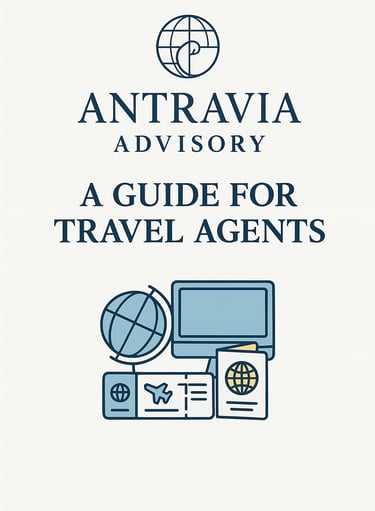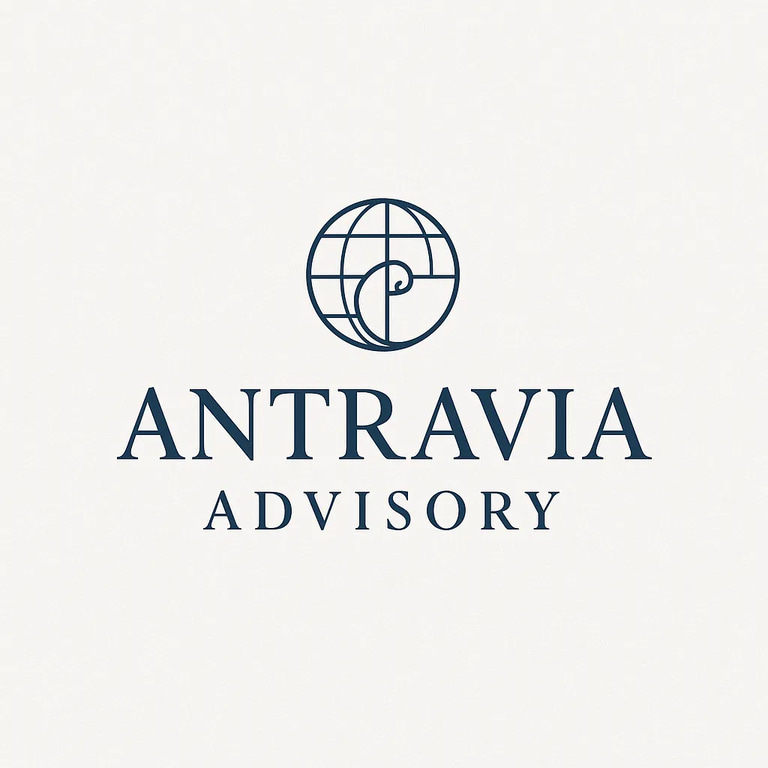
Travel Agent Finance Guide 2025: 7.1 Building a Scalable Tech Stack: Accounting, Automation, and CRM for Travel Agencies
Part 7.1 of the Antravia Travel Agent Finance Guide - Discover the best 2025 systems for U.S. travel agencies. Learn how to connect accounting, CRM, and quoting platforms, automate commission tracking, and build dashboards that scale with growth.
ANTRAVIA TRAVEL AGENT GUIDE
1/25/20256 min read


Part 7 Technology, Scaling, and Exit Planning
As agencies mature, financial priorities shift from survival to structure.
Part 7 of the Travel Agent Finance Guide focuses on how to scale sustainably by using technology, process discipline, and long-term financial planning to build transferable business value.
This section connects the operational work of Parts 4–6 to the strategic horizon: how to run your agency as an asset, not just an income stream.
7.1 Building a Scalable Tech Stack: Accounting, Automation, and CRM for Travel Agencies
How to choose accounting and reporting systems that scale with growth.
Integrating CRM, booking, and financial data for real-time visibility.
Automating reconciliations, payables, and commission tracking.
Building dashboards for key metrics (cash, margin, client type, region).
7.2 Growing Beyond Solo: Payroll, Compliance, and Independent Contractors
When to move from sole proprietor to employer — payroll vs. 1099 setups.
Financial implications of using independent contractors (ICs) vs. employees.
Compliance risks under U.S. Department of Labor and IRS definitions.
How to manage multi-state reporting and benefits as you expand.
7.3 Retirement and Wealth Planning for Travel Advisors
How to structure personal and business finances for long-term security.
Setting up SEP-IRAs, Solo 401(k)s, and profit-sharing plans.
Planning cash-flow continuity for semi-retirement or succession.
Using retained earnings and dividends tax-efficiently.
7.4 Valuation and Exit Strategies
What drives business value in a travel agency.
How to make profits predictable and transferable.
Preparing financial statements and KPIs for buyers or investors.
Structuring sales or mergers to minimize tax and protect legacy.


Part 7.1 Building a Scalable Tech Stack: Accounting, Automation, and CRM for Travel Agencies
Building a Scalable Financial and Technology Backbone for Travel Agencies
Accounting systems sit at the heart of every successful travel agency, but scaling beyond a one-person operation demands more than good bookkeeping and accoutning systems. The systems you choose, from accounting, CRM, quoting, reporting, and payment, determine how efficiently you can grow, how reliable your data becomes, and how confidently you can sell or expand the business later.
This section builds on the basics outlined in 2.2 Accounting Systems That Work, moving from day-to-day setup into the full digital architecture that supports a growing U.S. agency.
1. Core Accounting Systems: Choosing for Scale
This is a high level summary, as we explore this in more detail under - Best Accounting Systems for Travel Agents in 2025
For small agencies, QuickBooks Online still leads due to its strong bank-feed automation, reliable integrations, and IRS-compliant audit trail. For agencies with international suppliers, Xero offers stronger multi-currency handling and better VAT recording for EU or UK trips.
As revenue passes $1 million or staff grow beyond five advisors, mid-tier platforms such as Sage Intacct or NetSuite become valuable. Both allow consolidated reporting across multiple brands or divisions, deferred-revenue control, and departmental P&L tracking.
Cost insight:
QuickBooks Online Advanced ≈ $200 / month
Xero Established ≈ $78 / month
Sage Intacct and NetSuite typically from $1 500 / month upwards for hosted-agency scale
Key integrations: ClientBase, Travefy Pro, TravelJoy, Ramp, Expensify, TaxJar, Avalara
2. CRM and Booking Platforms: The Front End of Accounting
A robust CRM converts client activity into measurable revenue. Among the CRM systems most widely used by U.S. travel advisors, each offers distinct strengths and integration options:
ClientBase Online (Travel Leaders) is known for its deep GDS linkages and built-in commission tracking. It integrates smoothly with QuickBooks Online, Travefy, and Outlook, making it a strong choice for host-network advisors. Pricing generally starts around $40 per user per month.
TravelJoy combines a proposal builder, digital client forms, and embedded payment collection. It connects directly with QuickBooks Online, Stripe, and Zapier, offering an affordable automation bridge at roughly $30 per user per month.
Travefy Pro is best known for its quote and itinerary-building features, linking with Xero, ClientBase, Gmail, and Outlook. Subscriptions typically begin at $39 per user per month.
HubSpot CRM focuses on sales pipelines, lead management, and email automation. It integrates with QuickBooks Online and Zapier, with a free tier available and paid plans starting from $20 per user per month.
VacationCRM (VCRM) is a dedicated host-agency ecosystem designed around commission and group-booking management. It connects with SABRE and ClientBase, and pricing is usually arranged directly through the host network.
Financial takeaway: integrated CRMs reduce missed commissions and shorten invoice-to-cash cycles by 10–20 days on average.
3. Quote Builders and Workflow Tools
Quoting systems convert leads into billable bookings while maintaining brand consistency and cost control.
Travefy Pro: itinerary automation and embedded payment links; integrates with QuickBooks for seamless invoicing.
Tourwriter: advanced cost-sheet builder favored by FIT and group operators; integrates with Xero for deposit control.
Wetu: strong for visual proposals, particularly safari or multi-country programs.
Workflow and collaboration tools such as Trello, Asana, and ClickUp allow task automation (document requests, balance reminders, visa checks) that feed data into CRM and accounting.
4. Expense Management, Payments, and Compliance Automation
Expense automation turns compliance from a year-end chore into a daily routine.
Ramp and Divvy: corporate-card platforms with instant expense coding and receipt matching.
Expensify AI or Dext: extract supplier data and upload directly to your accounting platform.
Stripe and Square: merchant platforms for direct client payments; both connect to QuickBooks Online for automatic fee reconciliation.
Compliance add-ons such as Avalara, TaxJar, and ZenBusiness Compliance handle state-sales-tax filing, BOI tracking, and entity renewals, which are critical as the 2025 IRS e-filing thresholds expand.
For more information, also review our US Sales Tax page.
5. Analytics and Forecasting Systems
For growing agencies, static P&Ls are not enough - Analytics tools connect your accounting and CRM data for real-time visibility:
Power BI (Microsoft): links to QuickBooks, Xero, or Excel for automated dashboards tracking margin by product, region, or advisor.
Fathom Analytics: integrates directly with QuickBooks Online to display liquidity, profitability, and growth KPIs.
Tableau Cloud: ideal for multi-entity or franchise agencies consolidating global data.
Used properly, these tools replace spreadsheets and provide board-ready visuals for investors or bank financing.
6. Automation and AI Integration
2025 platforms increasingly use AI for reconciliation, cash-flow prediction, and compliance alerts.
Examples include:
QuickBooks Online Advanced AI: flags duplicate supplier invoices and predicts short-term cash shortages.
Expensify AI: classifies travel expenses automatically for IRS Schedule C compliance.
HubSpot AI: generates follow-up emails and client proposals based on CRM behavior.
Microsoft Copilot for Excel: runs scenario models (“what if airfare rises 8%?”) directly from accounting data.
Each tool replaces manual review time with analytics and prevention — adding measurable return on investment.
7. Migration and Change Management
Switching systems is costly if unmanaged.
Before migrating:
Reconcile all open invoices and supplier balances.
Archive legacy data (minimum seven-year retention).
Map old chart-of-accounts codes to new structures.
Run dual reporting for one full cycle before closing the old system.
A well-planned migration avoids loss of historical data that buyers, auditors, or investors may require later.
8. Building an Integrated Tech Stack for Exit Value
When it’s time to sell or scale, clean, connected systems are worth real money.
Buyers pay premiums for:
Consistent revenue recognition policies across systems.
Documented integrations showing verified margin data.
Automated audit trails and low manual intervention.
A streamlined tech stack doesn’t just save time. as it can increase agency valuation by 10–15 percent in M&A negotiations.


References for Part 7.1 Building a Scalable Tech Stack: Accounting, Automation, and CRM for Travel Agencies
Intuit QuickBooks Online – Feature and integration list (2025)
https://quickbooks.intuit.com/Xero Inc. – Multi-currency and automation updates (2025)
https://www.xero.com/Deloitte – 2025 Travel Industry Outlook: Efficiency and Automation
https://www.deloitte.com/Microsoft Power BI – Business-intelligence integrations for SMEs
https://powerbi.microsoft.com/U.S. SBA – Small-business automation and record-keeping guidance
https://www.sba.gov/
Acknowledgements
Antravia would like to thank our consulting clients and industry partners who generously shared their time, insights, and real-world case studies. All client examples have been anonymized and edited for clarity, but they are based on true advisory engagements and reflect real decisions, challenges, and financial outcomes from across the travel industry.


Antravia Advisory
Where Travel Meets Smart Finance
Email:
Contact us:
Antravia LLC
© 2025. All rights reserved. | Disclaimer | Privacy Policy | Terms of Use | Accessibility Statement
Antravia.com - Global site of the Antravia Group.
Antravia.com | Antravia.co.uk | Antravia.ae |
Finance.travel | Tax.travel | Consultancy.travel | Vat.travel | Vat.claims |
USSales.tax | EuroVAT.tax | UKVAT.tax |
contact@antravia.com
Antravia LLC
4539 N 22nd St., Ste. N
Phoenix
Arizona
85016
